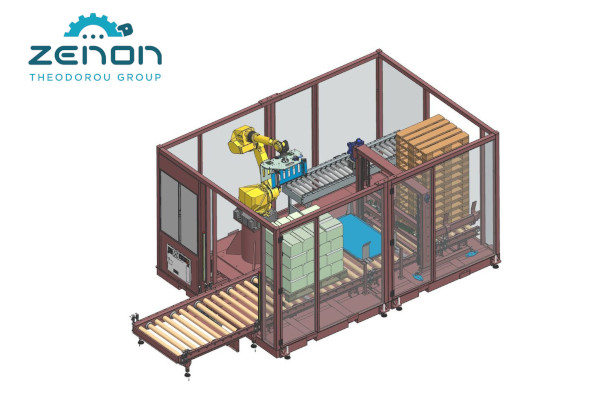![]()
Evangelos A. Theodorou, Ph.D. (Cambridge)
Theodorou Group President
INTRODUCTION
Industrial automation is at the heart of the new industrial revolution. Although much has been written on this subject, we believe that there is a significant lack of information that focuses on how industrial production is affected in its daily life and consequently - what steps industrial enterprises must take to take advantage of the new opportunities.
In this article we introduce the concept of Connected Automation as the evolution of classical industrial automation. We look at the new structures of Connected Automation, the technologies involved, the applications and the opportunities offered. Finally, we provide a practical guide to developing implementation strategies.
THE CONCEPT OF CONNECTED AUTOMATION
Classical automation, which has been with us for the last few decades, has made it possible to optimize the functions of the various machines involved in the production process. The new industrial revolution requires much more. Machinery must communicate with each other and be synchronized in such a way that their overall productivity can be improved. And of course, improving productivity requires further production integration with other enterprise systems, such as sales, raw material warehouses, finished products, accounting, and so on, which in recent years have been greatly digitized.
By Connected Automation we mean the expansion of classic automation that allows machines, digital applications and human resources to communicate with each other and function as a single whole. Connected Automation can be applied to any production process involving machinery, digital systems and human resources, with the most typical examples being industrial enterprises, warehouses and supply chain companies in general. In other words, this is the gateway to the new industrial revolution.
THE NEW TECHNOLOGIES
It is well known that every industrial revolution requires the availability of new technologies. Especially, Connected Automation requires many new technologies. Some of them are:
-
Internet of Things Technology (ΙοΤ)
IoT technology gives us smart sensors, cameras, PLC’s and other smart components that overturn the classic strict structures of automation systems with the new logic “Everything communicates with everything”. This means that digital technology is inextricably linked to the heart of automation.
-
The new robotics
Robots have been used for many decades in industrial packaging, such as automatic palletizing, automatic case packing and most recently in automatic pick and place.
The most important progress here is the reduction of costs per robot and the availability of standard robotic modules for specific applications. The result is the possibility of introducing robotics to even "smaller" businesses, something that seemed unreal a few years ago.
Another progress is the availability of smart sensors that allow robots to perform more and more "difficult" functions.
A new trend is the ability to move the robot itself instead of remaining static in some position. In this way the robot can serve more lines or more functions, which achieves greater economy.
Despite their reduced costs, robots are getting faster, their "placement" accuracy and repeatability are increased, while their driver programs are becoming smarter and offer much more flexibility and interconnection capabilities with other robots, with central information systems, in other words robots are now an integral part of the digital factory. Other developments include the appearance of CoBots (Collaborative Robots), small robots that can work harmoniously with operators without the risk of injuring people and the extension of the term robot, to include more general systems (with or without movement) automatic performing various operations within the factory. This new vision is essentially the expansion of robotics in automation, in which computer and digital technology are increasingly playing a role.
-
The digital technology
Digital technology offers us a wide variety of equipment and applications that can be integrated into production processes. Indicatively, we mention CLOUD, Artificial Intelligence, BIG DATA, mobility systems, 3D Printing, applications and programs that incorporate smart algorithms for predictions, programming, execution, management, etc.
Here we should also mention the new types of industrial servers that allow the interconnection between devices, the availability of production equipment and machines with direct interconnection capabilities, high-speed wireless telecommunications (5G, Wi-Fi, etc.) and the bots that are digital applications designed to perform standard and repetitive functions.
THE APPLICATIONS OF CONNECTED AUTOMATION
It is clear that new technologies are now giving us enough tools to develop applications that can significantly boost production processes. It is almost impossible to list all these applications, but we can categorize them as follows:
- ON LINE monitoring and measurement of the production process, possibility of automatic and remote interventions.
- Optimal programming, function synchronization, productivity increase, cost reduction
- Upgrading the role of employees and improving their safe working conditions
- Flexibility and faster product changeovers
- Reduction of energy costs
- Improving the operation of the supply chain and integrating it to industrial production and packaging
- Traceability, product quality and meeting the requirements of customers, end consumers, government agencies
- Electromechanical equipment maintenance procedures, ensuring greater reliability and higher efficiency
THE REAL OPPORTUNITY
In addition to the technologies and applications of Connected Automation, the real opportunity given to businesses is the ability to change the mentality of its people and how to deal with business operations.
The transformation of the human mentality is always the goal of every business and Connected Automation offers a unique opportunity to achieve this difficult task.
Some examples:
- Connected Automation brings closer parts of the business that traditionally operated independently, if not competently. Production, technical management, IT, supply chain, supplies, quality control must learn to work more closely together. The role of the "multiengineer" begins to appear, that is, the engineer who understands and handles different technologies, mechanical, electrical, electronic, IT, telecommunications and automation. At the same time, similar requirements are being developed by external partners. The new type of Systems Integrator needs to know in depth all the above technologies in order to be able to help the company in their transformation towards the new industrial revolution.
- Traditionally, every business is called upon to best meet the needs of the market. Connected Automation can help the business offer something much more important: products and services that shape new trends and consumer habits. Businesses that offer such innovative added value are the ones that will prevail in the new business landscape.
- Businesses can now reconsider the way they compete in the market and look for new types of partnerships, so that they can focus more on specific areas of their business.
IMPLEMENTATION STRATEGIES
Each company is called upon to draw up its own strategic plan for its transition to the new era. However, each plan must take into account the following rules:
- Transformation is an ongoing process and must be executed step by step. Once the successful introduction of a step, then we move on to the next, but we must have planned it in advance.
- Every implementation step must faithfully follow the company's core strategy.
- Not technology for technology. Technology only gives us tools for applications. The application of technology is the goal for every business.
- Technologies change and evolve fast in contrast to the central design that needs to change at a much slower pace. No business wants to own equipment not meeting its current needs. A modern approach to this major problem is SERVITIZATION, which enables the use of equipment in the form of VAS (Value Added Services) by specialized equipment suppliers. When the equipment can no longer meet the needs of the business it is simply replaced with other modern equipment and the "old" equipment can be used by the VAS supplier in another company that is in a previous stage of transformation. More and more companies are adopting the logic of SERVITIZATION, while in the not so distant future SERVITIZATION is expected to prevail as the main method of "acquiring" capital equipment.
- The role of staff should be constantly upgraded and repetitive and standardized functions should be gradually assigned to the machines.
CONCLUSION
The new industrial revolution is here and no business can afford to ignore it. The good news is that the road to transformation is now paved, as long as businesses deal with the issue with the necessary diligence and make sure they are informed by sources that have proven experience in new technology applications.

Dr. Evangelos Theodorou is President & CEO of the Theodorou Group. He holds a degree in Engineering – NTUA (National Technical University of Athens) and holds a Ph.D. in Electronic Systems from the University of Cambridge, England. He has been a lecturer at the Department of Electrical and Computer Engineering of the NTUA.



